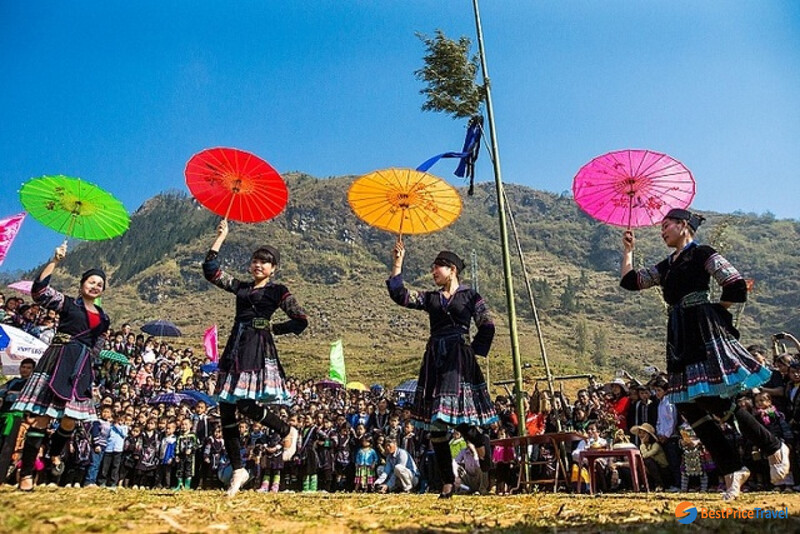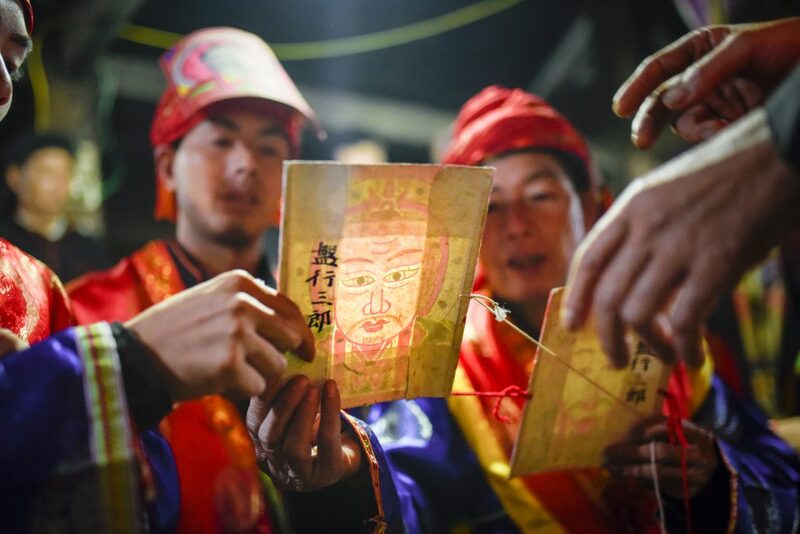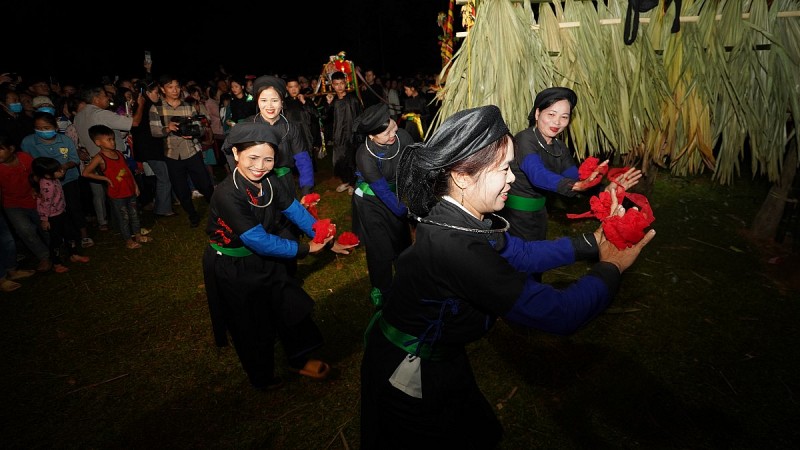Famous for its majestic natural scenery and spectacular mountain passes, Ha Giang festivals also harbors a unique cultural treasure manifested through its distinctive traditional festivals. Each festival is a vibrant symphony of colors, offering visitors the chance to immerse themselves in the diverse cultural space of the ethnic minorities, explore ancient customs and traditions, and enjoy unique cultural pleasures. Join Ha Giang Motorbike Tours to explore through this article!
Top 10 most famous Ha Giang traditional festivals
Ha Giang Loop Tour is a mountainous province in northern Vietnam, renowned for its majestic natural landscapes, unique villages, and distinctive cultures. The area also attracts visitors with traditional festivals that take place year-round, deeply reflecting the cultural identity of the local ethnic minorities. Here are some of the most remarkable festivals in Hà Giang that you should attend if you have the opportunity:
Lunar New Year (Tet Nguyen Dan)
The Lunar New Year, or simply Tet, is the most important festival of the year in Vietnam, and Ha Giang is no exception. This festival is celebrated from late January to mid-February according to the lunar calendar, marking the beginning of a new year filled with joy and hope.
This is a warm time for family reunions, when people gather with their families and share traditional meals to honor their ancestors. Banh Chung – the symbol of Tet – is made from sticky rice, green beans, pork, and dong leaves, offering a chewy and flavorful taste that represents prosperity and abundance for the new year. Homes are adorned with the vibrant colors of peach blossoms, the flowers that signal the arrival of spring, bringing joy and hope to everyone. To participate in the festivals in Ha Giang, please register for our Ha Giang tour here.
Long Tong Festival – Ha Giang traditional festivals
The Lồng Tông Festival is a unique traditional festival of the Tày people in the provinces of Tuyên Quang, Cao Bằng, Hà Giang, Lào Cai, Bắc Kạn, and Thái Nguyên. The festival is usually held on the 8th day of the first lunar month each year, carrying the meaning of praying to the heavens for favorable weather, abundant harvests, and a prosperous and happy life.
The Lồng Tông Festival consists of two main parts: the ceremonial part and the festive part. The ceremonial part is solemn with rituals to worship the rice deity and the village’s tutelary god, praying for favorable weather and bountiful crops. The festive part is lively with folk games such as tug of war, cloth ball throwing, walking on stilts, sli singing, and khèn dancing, attracting a large number of local people and tourists to participate.
The Lồng Tông Festival is not only an occasion for the Tày people to pray for a prosperous life but also an opportunity for them to remember their ancestors and grandparents and to demonstrate community solidarity. The festival is also a unique cultural feature of the Tày people, contributing to the richness of the Vietnamese national cultural treasure.
This festival is held in many places, but the most famous ones are the Lồng Tông Festivals in Tuyên Quang, Hà Giang, Cao Bằng, and Lào Cai.
See more: Best Time to Visit Ha Giang Weather & Traveling Tips

Gau Tao Festival
The Gầu Táo Festival is a unique festival of the Hmong people in Northwest Vietnam, typically held on the 4th day of the Lunar New Year. This is the largest festival of the year for the Hmong people, deeply imbued with cultural identity and spiritual values of the ethnicity.
The Gầu Táo Festival has ancient origins, linked to the legend of the creation of mankind. According to the legend, after Pangu created the heavens and the earth and fashioned the first man and woman, these two did not know how to bear children. They prayed to Heaven and Earth for help. Heaven and Earth, moved by their plight, sent a golden bird to the earthly realm carrying two stone eggs. The two stone eggs hatched into two children, a boy and a girl. These two children became the ancestors of mankind.
To express gratitude to Heaven, Earth, and their ancestors, the Hmong people organize the Gầu Táo Festival to give thanks and pray for a new year with favorable weather, abundant cross, and happy, healthy families.
The Gầu Táo Festival is held in many places in Northwest Vietnam, but it is most famous in the provinces of Lào Cai, Hà Giang, Yên Bái, and Điện Biên. Visitors can participate and experience the unique cultural traits of the Hmong people.

Du Stem Festival
To express gratitude to the agricultural gods and pray for abundant harvests, the Nung people annually organize the Du Than Festival in the tenth lunar month. This is one of the unique festivals rich in the cultural identity of the Nung ethnic group, attracting visitors with its lively and vibrant atmosphere and solemn traditional rituals.
The Du Than Festival takes place with many solemn ceremonies, the most prominent of which is the water buffalo sacrifice. A strong and healthy buffalo, carefully selected to symbolize strength and prosperity, is offered to the gods as a prayer for favorable weather and bountiful crops in the coming year. After the sacrifice ceremony, the buffalo meat is evenly distributed among the villagers to enjoy together in a warm communal meal, reflecting the spirit of unity and cohesion of the Nung people.
Level Sac Festival
The Cấp Sắc Festival is an important traditional ceremony of the Red Dao people in Northwest Vietnam. This ritual marks the coming of age for Dao men and is also a unique cultural aspect of this ethnic group.
The Cấp Sắc Festival is usually held at the end of the year, lasting from three to five days. The ceremony includes various parts, with the most significant being the “Cấp Sắc” ritual. During this ritual, a Dao man is “promoted” from a boy to a young man, given a new name, and granted the right to participate in important community activities.
The Cấp Sắc Festival is an occasion for the Red Dao people to express their religious beliefs and to strengthen community bonds. This festival attracts many visitors to the Northwest to learn about the unique culture of the Red Dao people.

Khau Vai Love Market
Every year, at the end of the third lunar month, following the majestic Khau Pha Pass, we find our way back to the legendary Khau Vai Love Market – where love and culture blend into the rhythm of life in the Northwestern mountains.
Khau Vai Love Market – a name that evokes romantic love stories, originates from the legend of Ba and Ut. The market is held on the 26th and 27th of the third lunar month, becoming a rendezvous for couples from distant villages to gather and express their feelings.
Khau Vai Love Market is not only a matchmaking place for couples but also a vibrant cultural tapestry of the local ethnic minorities. Young men and women dress in their splendid traditional attire, bringing with them the sounds of the khèn and sáo flutes, creating a lively and bustling atmosphere.
Fire dancing festival of Pa Then
The Fire Dance Festival is a unique festival organized by various ethnic minorities in Vietnam, most famously by the Pà Thẻn people in Hà Giang. This festival usually takes place in October or November of the lunar calendar, after the harvest season.
The Fire Dance Festival is a spiritual ritual that expresses gratitude to the deities for granting a bountiful harvest and prays for luck and peace in the new year. The festival is also an occasion for the ethnic community to come together, have fun, entertain, and strengthen neighborhood bonds.
The Fire Dance Festival is a distinctive cultural beauty of Vietnam, attracting tourists from all over the world to visit and experience. If you have the opportunity to visit Vietnam, be sure to attend the Fire Dance Festival for an unforgettable experience.

Buckwheat flower festival – Ha Giang
The Buckwheat Flower Festival is a unique festival held annually on the Dong Van Stone Plateau, Ha Giang Province, Vietnam. The festival usually takes place in October and November when the buckwheat fields are in full bloom, coloring the entire region in shades of pink.
The Buckwheat Flower Festival is an opportunity for visitors to admire the beauty of this characteristic flower of the northern mountainous region. Additionally, visitors have the chance to participate in traditional cultural activities of the local ethnic minorities, such as khèn dancing, sli singing, tug-of-war, and pushing sticks.
The Buckwheat Flower Festival has become one of the most attractive tourist destinations in Vietnam. The festival draws visitors from all over the country and even internationally to come and experience it.
You can participate in this festival at various locations on the Dong Van Stone Plateau, mainly in the districts of Dong Van, Meo Vac, and Xin Man.

Cau Trang festival
Held on the Full Moon day of the Eighth Lunar month (Mid-Autumn Festival), the Cau Trang Festival consists of rituals and festivities.
Through generations, the Tay people of Ban Loan village have upheld this spiritually rich folk festival to welcome the Moon Mother and fairy maidens during the Mid-Autumn celebrations. The Moon Mother blesses the villagers, praying for abundant harvests, favorable weather, peaceful lives, and good fortune.
Elders perform rituals to invoke blessings and prosperity, while afterwards, everyone gathers for communal feasting, drinking, and dancing around the festival table.
Both men and women dress in their finest attire, especially the young women adorned with silver bracelets, necklaces, and hairpins, shining beautifully. They joyously sing folk songs, celebrating their love for their homeland and praising the happiness of couples.

Rain praying ritual of the Lo Lo in Ha Giang
The Rain-Invoking Festival is usually held during harsh weather years on the 15th, 17th, and 19th days of the third lunar month annually. Its purpose is to pray for divine protection and favorable weather for abundant crops, ensuring villagers’ prosperity and fullness of life.
Locals gather to prepare offerings and use traditional musical instruments such as the two-stringed fiddle, flute, horn, bamboo flute, and bronze drum to accompany ceremonial dances and folk songs. Each ritual segment of the festival lasts approximately two hours.
The ceremony begins with the first offering to invite the spirits of the four directions to witness the villagers’ rain-invoking ritual and seek their blessings for harmonious weather and fruitful harvests.

What to note when participating in festivals in Ha Giang
The festivals in Ha Giang not only attract domestic and international tourists with their interesting, cultural, and traditional histories. However, when participating, you should take note of the following:
Before joining
- Exploring the festival: Choose a festival that matches your interests and schedule. Learn thoroughly about the itinerary, culture, and local customs to ensure the best preparation.
- Booking a hotel: Festivals in Ha Giang often attract many tourists, so you need to book a room early to avoid the situation of no available rooms.
- Preparing attire: Bring clothing suitable for the Ha Giang weather and festival activities. It is advisable to bring comfortable footwear for easy movement.
- Preparing cash: Some places at the festival may not accept card payments.
- Bringing medicine: Prepare some common medicines such as cold medicine, digestive medicine, insect repellent, etc.

While participating
- Respecting local culture: Dressing appropriately, behaving properly, and respecting local customs and traditions.
- Maintaining general cleanliness: Not littering, protecting the surrounding environment.
- Being careful with personal belongings: Taking care of personal belongings, especially in crowded places.
- Drinking alcohol responsibly: Not drinking too much alcohol, ensuring safety for oneself and others.
- Participating in festival activities in a civilized manner: Engaging in games and festival activities in a cheerful and healthy manner, without violating regulations.
After joining
- Clean up garbage: Gather your garbage and put it in the trash bin.
- Share experiences: Share photos and feelings about the festival with friends and family.
The Ha Giang traditional festivals paint a vibrant cultural picture, where visitors can experience unique cultural values and connect with the local community. Come to Ha Giang during the festival season to immerse yourself in the lively atmosphere and cherish unforgettable memories.
Meditours Ha Giang, a leading tour operator with years of experience delivering unforgettable adventures, can make it happen. Imagine traveling by motorbike, trekking through breathtaking landscapes and camping under the stars. We provide the highest quality service to ensure your comfort and safety throughout the journey. Don’t miss out – register using the following link: https://meditourshagiang.com/


